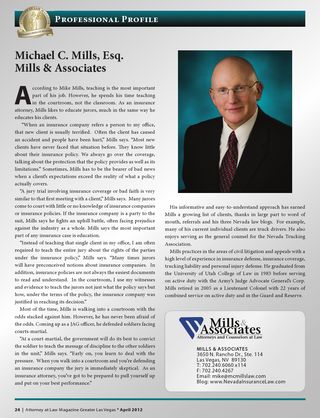 The State of Nevada compels automobile drivers to have insurance. You can learn more about Nevada’s Compulsory Insurance Law HERE.
The State of Nevada compels automobile drivers to have insurance. You can learn more about Nevada’s Compulsory Insurance Law HERE.
There are two ways to satisfy the compulsory insurance requirement.
Most people are familiar with the Nevada law that requires the OWNER of a motor vehicle to continuously maintain insurance. This “Owner’s” coverage is the type of insurance that most people are familiar with.
However, Nevada law allows for an alternative way to satisfy the compulsory insurance requirement. That alternative is an “OPERATOR’S POLICY”. The law is found in NRS 485.186.
The idea of operator’s policy alternative is not unique to Nevada. The concept of an “operator’s policy” appears to exist in every state in the US.
However, Nevada’s version of the “operator’s policy” is unique. In many states, the applicant must demonstrate that he or she does not own a vehicle in order to qualify to purchase an operator’s policy. See “Automobile liability insurance: operator’s policies”, 88 A.L.R.2d 995.
For example, in California, an applicant cannot own any other vehicle anywhere to qualify as a holder of a California operator’s policy. Cal. Veh. Code § 16452.
Apparently, these operator’s policies are less expensive because a driver without a car will not be driving as often. “Automobile liability insurance: operator’s policies”, 88 A.L.R.2d 995, 1a, fn5.
But Nevada’s operator’s policy statute does not look anything like the statutes in the other states. In Nevada, an insurance producer cannot sell an “operator’s policy” except where the applicant meets the following requirements:
- An operator’s policy of liability insurance may only be issued to a person if:
(a) The number of motor vehicles that the person owns is greater than the number of persons in his or her household who possess a driver’s license; and
(b) Each person in his or her household who possesses a driver’s license is covered by an operator’s policy of liability insurance.
NRS 485.186(2).
In other words, in order to qualify for an “operator’s policy”, the insurance applicant must have more motor vehicles in his or her household than there are licensed drivers.
In addition, to qualify as a purchaser of an “operator’s policy”, the applicant must confirm that every member of the applicant’s household who possesses a driver’s license has his or her own operator’s policy.
What was Nevada thinking when it created this unusual insurance scheme? Nevada’s Consumer’s Guide to Auto Insurance Rates, explains why this law exists. At page 22 of the Guide, the Nevada Division of Insurance says:
An operator’s policy is different from standard liability insurance. . . This [operator’s] type of auto insurance is intended primarily to serve the needs of automobile collectors. By law, under an operator’s policy, the number of motor vehicles that the policyholder owns must be greater than the number of persons in the household who possess a driver’s license, and each person in his or her household who has a driver’s license must carry an operator’s policy of liability insurance. This insurance coverage protects the driver, not the car. That is, the driver would be insured no matter what vehicle was driven. This insurance coverage does not cover another person driving your car, either with or without your consent.
I cannot find an “operator’s policy” scheme that is quite like Nevada’s. Unlike the other state’s statutes, Nevada makes no mention of non-ownership. In fact, Nevada’s statutes go 180 degrees in the opposite direction. The applicant of an operator’s policy in Nevada must have multiple vehicles and more cars than licenses in the household.
If you have questions about compulsory insurance or Nevada owners or operators automobile policies, please contact Mike Mills at 702.240.6060×114.
 Follow
Follow Email
Email


